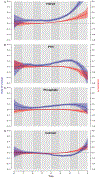Longitudinal Evolution of Markers of Mineral Metabolism in Patients With CKD: The Chronic Renal Insufficiency Cohort (CRIC) Study
- PMID: 31668375
- PMCID: PMC7012684
- DOI: 10.1053/j.ajkd.2019.07.022
Longitudinal Evolution of Markers of Mineral Metabolism in Patients With CKD: The Chronic Renal Insufficiency Cohort (CRIC) Study
Abstract
Rationale & objective: The pathogenesis of disordered mineral metabolism in chronic kidney disease (CKD) is largely informed by cross-sectional studies of humans and longitudinal animal studies. We sought to characterize the longitudinal evolution of disordered mineral metabolism during the course of CKD.
Study design: Retrospective analysis nested in a cohort study.
Setting & participants: Participants in the Chronic Renal Insufficiency Cohort (CRIC) Study who had up to 5 serial annual measurements of estimated glomerular filtration rate, fibroblast growth factor 23 (FGF-23), parathyroid hormone (PTH), serum phosphate, and serum calcium and who subsequently reached end-stage kidney disease (ESKD) during follow-up (n = 847).
Exposure: Years before ESKD.
Outcomes: Serial FGF-23, PTH, serum phosphate, and serum calcium levels.
Analytical approach: To assess longitudinal dynamics of disordered mineral metabolism in human CKD, we used "ESKD-anchored longitudinal analyses" to express time as years before ESKD, enabling assessments of mineral metabolites spanning 8 years of CKD progression before ESKD.
Results: Mean FGF-23 levels increased markedly as time before ESKD decreased, while PTH and phosphate levels increased modestly and calcium levels declined minimally. Compared with other mineral metabolites, FGF-23 levels demonstrated the highest rate of change (velocity: first derivative of the function of concentration over time) and magnitude of acceleration (second derivative). These changes became evident approximately 5 years before ESKD and persisted without deceleration through ESKD onset. Rates of changes in PTH and phosphate levels increased modestly and without marked acceleration around the same time, with modest deceleration immediately before ESKD, when use of active vitamin D and phosphate binders increased.
Limitations: Individuals who entered the CRIC Study at early stages of CKD and who did not progress to ESKD were not studied.
Conclusions: Among patients with progressive CKD, FGF-23 levels begin to increase 5 years before ESKD and continue to rapidly accelerate until transition to ESKD.
Keywords: CKD progression; Chronic kidney disease (CKD); biomarker; calcium; disordered mineral metabolism; end-stage renal disease (ESRD); fibroblast growth factor 23 (FGF-23); incident kidney failure; kidney function; longitudinal trends; parathyroid hormone (PTH); phosphate; serial measurements.
Copyright © 2019 National Kidney Foundation, Inc. Published by Elsevier Inc. All rights reserved.
Figures






References
-
- Hasegawa H, Nagano N, Urakawa I, et al. Direct evidence for a causative role of FGF23 in the abnormal renal phosphate handling and vitamin D metabolism in rats with early-stage chronic kidney disease. Kidney Int. 2010;78(10):975–980. - PubMed
Publication types
MeSH terms
Substances
Grants and funding
- K23 DK097183/DK/NIDDK NIH HHS/United States
- R01 DK072231/DK/NIDDK NIH HHS/United States
- UL1 TR002548/TR/NCATS NIH HHS/United States
- R01 DK076116/DK/NIDDK NIH HHS/United States
- UL1 TR000003/TR/NCATS NIH HHS/United States
- KL2 TR001424/TR/NCATS NIH HHS/United States
- UL1 TR000439/TR/NCATS NIH HHS/United States
- K24 DK093723/DK/NIDDK NIH HHS/United States
- R01 DK094796/DK/NIDDK NIH HHS/United States
- UL1 RR029879/RR/NCRR NIH HHS/United States
- U01 DK061028/DK/NIDDK NIH HHS/United States
- UL1 TR000433/TR/NCATS NIH HHS/United States
- U01 DK060984/DK/NIDDK NIH HHS/United States
- U01 DK061021/DK/NIDDK NIH HHS/United States
- U24 DK060990/DK/NIDDK NIH HHS/United States
- U01 DK060980/DK/NIDDK NIH HHS/United States
- U01 DK099930/DK/NIDDK NIH HHS/United States
- U01 DK060963/DK/NIDDK NIH HHS/United States
- UL1 RR024131/RR/NCRR NIH HHS/United States
- R01 DK111952/DK/NIDDK NIH HHS/United States
- U54 GM104940/GM/NIGMS NIH HHS/United States
- M01 RR013987/RR/NCRR NIH HHS/United States
- R01 DK102438/DK/NIDDK NIH HHS/United States
- UL1 TR001422/TR/NCATS NIH HHS/United States
- U01 DK061022/DK/NIDDK NIH HHS/United States
- R01 DK081374/DK/NIDDK NIH HHS/United States
- UL1 TR000424/TR/NCATS NIH HHS/United States
- M01 RR016500/RR/NCRR NIH HHS/United States
- P20 GM109036/GM/NIGMS NIH HHS/United States
- U01 DK060902/DK/NIDDK NIH HHS/United States
- UL1 TR002003/TR/NCATS NIH HHS/United States
- R01 DK099199/DK/NIDDK NIH HHS/United States
- U01 DK060990/DK/NIDDK NIH HHS/United States
- R01 DK110087/DK/NIDDK NIH HHS/United States
- P30 DK114857/DK/NIDDK NIH HHS/United States
LinkOut - more resources
Full Text Sources
Medical

